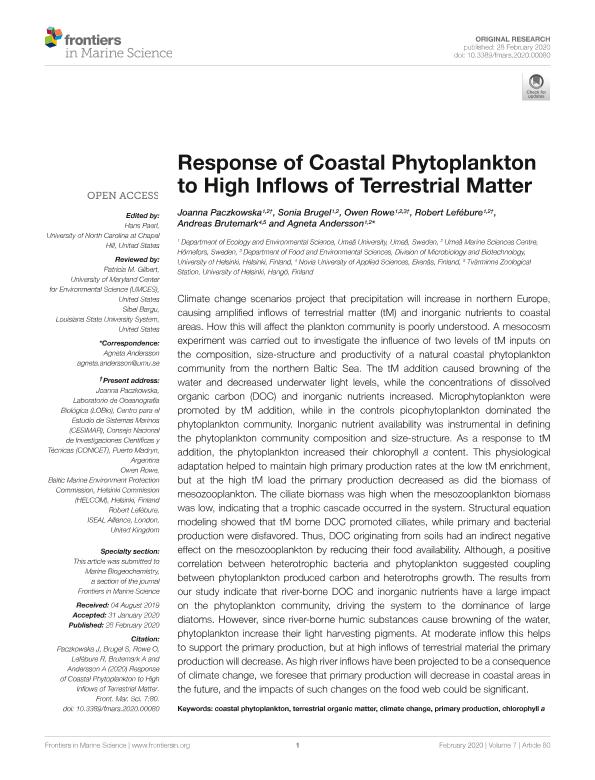Mostrar el registro sencillo del ítem
dc.contributor.author
Paczkowska, Joanna Marianna

dc.contributor.author
Brugel, Sonia
dc.contributor.author
Rowe, Owen
dc.contributor.author
Lefébure, Robert
dc.contributor.author
Brutemark, Andreas
dc.contributor.author
Andersson, Agneta
dc.date.available
2021-07-22T14:33:40Z
dc.date.issued
2020-02
dc.identifier.citation
Paczkowska, Joanna Marianna; Brugel, Sonia; Rowe, Owen; Lefébure, Robert; Brutemark, Andreas; et al.; Response of Coastal Phytoplankton to High Inflows of Terrestrial Matter; Frontiers Media S.A.; Frontiers In Marine Science; 7; 2-2020
dc.identifier.issn
2296-7745
dc.identifier.uri
http://hdl.handle.net/11336/136654
dc.description.abstract
Climate change scenarios project that precipitation will increase in northern Europe, causing amplified inflows of terrestrial matter (tM) and inorganic nutrients to coastal areas. How this will affect the plankton community is poorly understood. A mesocosm experiment was carried out to investigate the influence of two levels of tM inputs on the composition, size-structure and productivity of a natural coastal phytoplankton community from the northern Baltic Sea. The tM addition caused browning of the water and decreased underwater light levels, while the concentrations of dissolved organic carbon (DOC) and inorganic nutrients increased. Microphytoplankton were promoted by tM addition, while in the controls picophytoplankton dominated the phytoplankton community. Inorganic nutrient availability was instrumental in defining the phytoplankton community composition and size-structure. As a response to tM addition, the phytoplankton increased their chlorophyll a content. This physiological adaptation helped to maintain high primary production rates at the low tM enrichment, but at the high tM load the primary production decreased as did the biomass of mesozooplankton. The ciliate biomass was high when the mesozooplankton biomass was low, indicating that a trophic cascade occurred in the system. Structural equation modeling showed that tM borne DOC promoted ciliates, while primary and bacterial production were disfavored. Thus, DOC originating from soils had an indirect negative effect on the mesozooplankton by reducing their food availability. Although, a positive correlation between heterotrophic bacteria and phytoplankton suggested coupling between phytoplankton produced carbon and heterotrophs growth. The results from our study indicate that river-borne DOC and inorganic nutrients have a large impact on the phytoplankton community, driving the system to the dominance of large diatoms. However, since river-borne humic substances cause browning of the water, phytoplankton increase their light harvesting pigments. At moderate inflow this helps to support the primary production, but at high inflows of terrestrial material the primary production will decrease. As high river inflows have been projected to be a consequence of climate change, we foresee that primary production will decrease in coastal areas in the future, and the impacts of such changes on the food web could be significant.
dc.format
application/pdf
dc.language.iso
eng
dc.publisher
Frontiers Media S.A.

dc.rights
info:eu-repo/semantics/openAccess
dc.rights.uri
https://creativecommons.org/licenses/by/2.5/ar/
dc.subject
COASTAL PHYTOPLANKTON
dc.subject
TERRESTRIAL ORGANIC MATTER
dc.subject
CLIMATE CHANGE
dc.subject
PRIMARY PRODUCTION
dc.subject
CHLOROPHYLLA
dc.subject.classification
Biología Marina, Limnología

dc.subject.classification
Ciencias Biológicas

dc.subject.classification
CIENCIAS NATURALES Y EXACTAS

dc.title
Response of Coastal Phytoplankton to High Inflows of Terrestrial Matter
dc.type
info:eu-repo/semantics/article
dc.type
info:ar-repo/semantics/artículo
dc.type
info:eu-repo/semantics/publishedVersion
dc.date.updated
2020-07-20T19:28:41Z
dc.journal.volume
7
dc.journal.pais
Suiza

dc.journal.ciudad
Lausana
dc.conicet.avisoEditorial
Copyright © 2020 Paczkowska, Brugel, Rowe, Lefébure, Brutemark and Andersson. This is an open-access article distributed under the terms of the Creative Commons Attribution License (CC BY). The use, distribution or reproduction in other forums is permitted, provided the original author(s) and the copyright owner(s) are credited and that the original publication in this journal is cited, in accordance with accepted academic practice. No use, distribution or reproduction is permitted which does not comply with these terms.
dc.description.fil
Fil: Paczkowska, Joanna Marianna. Consejo Nacional de Investigaciones Científicas y Técnicas. Centro Científico Tecnológico Conicet - Centro Nacional Patagónico. Centro para el Estudio de Sistemas Marinos; Argentina. Universidad de Umea; Suecia. Umeå Marine Sciences Centre; Suecia
dc.description.fil
Fil: Brugel, Sonia. Universidad de Umea; Suecia. Umeå Marine Sciences Centre; Suecia
dc.description.fil
Fil: Rowe, Owen. Universidad de Umea; Suecia. Umeå Marine Sciences Centre; Suecia. University of Helsinki; Finlandia
dc.description.fil
Fil: Lefébure, Robert. Universidad de Umea; Suecia. Umeå Marine Sciences Centre; Suecia
dc.description.fil
Fil: Brutemark, Andreas. University Of Helsinki; Finlandia. Novia University of Applied Sciences; Finlandia
dc.description.fil
Fil: Andersson, Agneta. Universidad de Umea; Suecia. Umeå Marine Sciences Centre; Suecia
dc.journal.title
Frontiers In Marine Science

dc.relation.alternativeid
info:eu-repo/semantics/altIdentifier/doi/http://dx.doi.org/10.3389/fmars.2020.00080
dc.relation.alternativeid
info:eu-repo/semantics/altIdentifier/url/https://www.frontiersin.org/articles/10.3389/fmars.2020.00080/full
Archivos asociados
